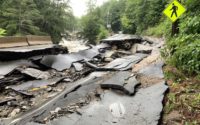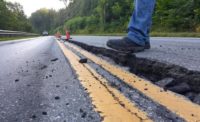A major rainstorm moving through the Northeastern U.S. over the weekend brought unexpectedly destructive flash floods to the region, killing at least one person in southeastern New York and inflicting serious damage on homes, businesses and infrastructure across New York, Vermont, Massachusetts and Maine. Flash flooding that began July 9 and continued in some areas into July 11 washed out bridges and buckled roads. President Biden authorized the Federal Emergency Management Agency to coordinate all disaster relief efforts and issued a disaster declaration for all fourteen counties in Vermont.
Pamela Nugent, a senior associate at infrastructure engineering firm Hardesty & Hanover in New York City and its development and operations manager for emerging markets, died July 9 near her home in Fort Montgomery, N.Y. She had been trying to save her father’s dog, the firm said on its website.
Earlier Storm Prep Mitigated Vermont Damage
The state of Vermont took the brunt of the storm. During a July 11 press briefing by Gov. Phil Scott (R), Vermont Agency of Transportation Secretary Joe Flynn said 78 state roads were closed and 18 roads were closed in the southeast of the state. Interstate 89 had also been shut down, but as of the morning of July 11 it had reopened with only one northbound lane.
A Reuters report indicated concerns that the Wrightsville Dam, 6.4 miles north of Montpelier, Vt., had 6 ft of storage capacity remaining, threatening to “overwhelm a dam protecting the state’s capital." The city Facebook page, however, notes that the dam is being monitored and a state dam safety representative believes only minimal increases beyond the current level can be expected at this point.
A spokesperson for the transportation agency says it has received no estimates on infrastructure damage with rescue operations still underway.
Vermont Dept. of Public Safety Commissioner Jennifer Morrison said there were no reports of any injuries or deaths in the state as of 9:30 a.m. July 11. But she emphasized that the response was still in the early stages and the focus was on saving lives with “life threatening isolations that we are trying to identify and rescue.”
“We have structural collapse teams staged across the state as well as fire and code inspectors ready to deploy as soon as the water recedes to ensure impacted buildings are safe,” she said.
Michael Cannon, program manager at Vermont Urban Search and Rescue, said local, state and federal partners had conducted 117 rescues, 67 evacuations from flooded homes, businesses or vehicles and 17 animals. “We are still in a dangerous part of this disaster; we still have reports of people trapped in flooded homes and vehicles,” he said.
Despite “historic and catastrophic” devastation from storms that delivered four times the amount of rain as Hurricane Irene did in 2011, flood mitigation during rebuilding after the hurricane appears to be helping reduce overall impact to infrastructure, Gov. Scott said.
The governor's team to date has seen fewer bridge failures than during Hurricane Irene, and Gov. Scott predicts the greatest impact will be “in the communities, the storefronts and the downtowns."
But he warned that while the rain has stopped and sun may come out in some areas, “that does not mean waters will immediately recede and they may in fact continue to rise” with predictions for more rain that “will have nowhere to go in the oversaturated ground,” he said. “Let me make it clear, we are not out of the woods.”
State of Emergency in Two NY Counties
In New York, Gov. Kathy Hochul (D) declared a state of emergency for Orange and Ontario Counties due to flood damage. She told reporters on July 10 that the Biden Administration pledged “all the help necessary” to rebuild as a flood watch remained in effect for most of eastern New York through July 11.
More than 8 in. of rain fell within hours in some areas in New York's Mid-Hudson region on July 9 and 10, while more than 5 in. of rain were reported in its Finger Lakes region. Damage could be in the tens of millions of dollars, or more, according to officials.
The historic Popolopen Bridge on US Route 9W in in Fort Montgomery is closed after it sustained major damage. The century-old deck truss bridge leading to the U.S. Military Academy at West Point was undergoing a rehabilitation but had been open to traffic when the rain began, according to a spokesperson for the New York State Dept. of Transportation.
“The damage to the bridge’s embankment that was caused by the storm is independent of the work that is being done as part of the rehabilitation project,” the spokesperson said in an email.
“The bridge is unsafe,” Jeff Morrissey, a bridge repair contractor for the state said in the AP video posted on July 11. “All of 9W was concrete at one time so they paved over the concrete but there’s a slab here…and it’s all eroded underneath it. The dirt is falling as we speak, it’s been doing it all day, the asphalt buckled and fell in.”
State engineers are developing a plan to repair the bridge and officials hope to open it to traffic by the end of the month, according to an Associated Press video.
The state DOT has deployed bridge inspection teams to the Hudson Valley region and is also assessing damage to roads.
The damage in Orange County, N.Y. includes a "compromised" wastewater plant and CSX freight tracks in about 10 locations.
"Last night was complete chaos," county executive Steve Neuhaus told reporters on July 10.
Engineering Manager Who Died Was Active in Industry
Nugent also served as assistant secretary for the New York Post of the Society of Military Engineers.
“Pam was very active in both our NYC Post and the NJ Post,” Michael Scarano, post secretary, wrote in an email to his members. “I was just on a virtual meeting with her the other day as we discussed the Joint Golf Outing that was originally to take place today. "
"I have known her for many years,” said Scarano.







Post a comment to this article
Report Abusive Comment